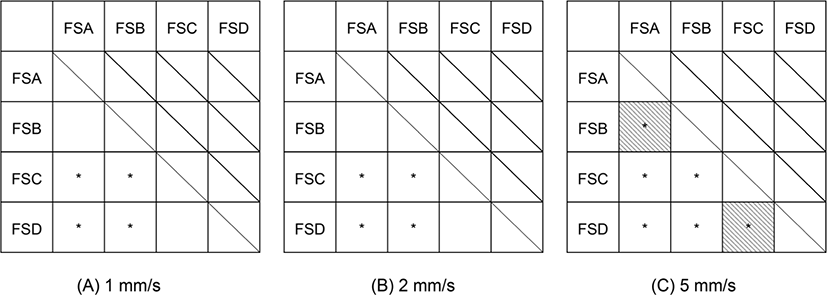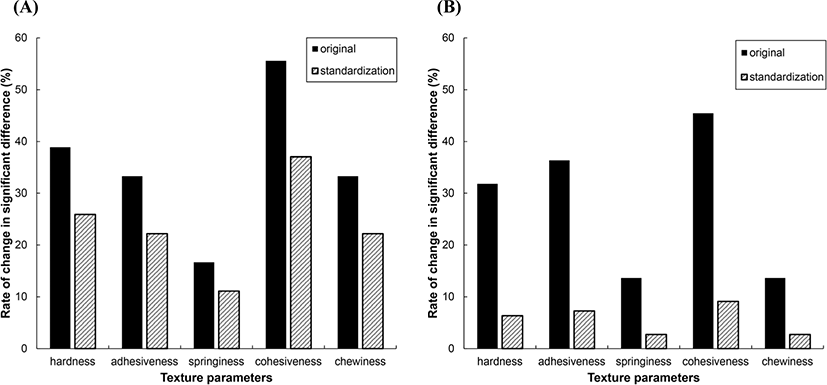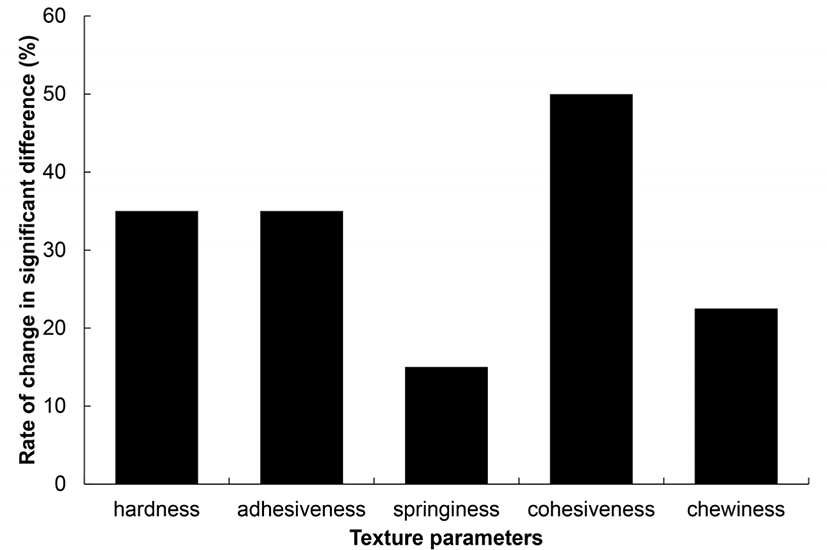Introduction
With development of the meat processing industry, the consumption of processed meat products has been increasing steadily. The production of processed meat in Korea has almost doubled, from 119,000 tons in 1996 to 228,000 tons in 2016, and the processed meat products increased in the order of sausage, ham, and bacon (Lim and Chin, 2018).
Various studies have been conducted on sausages, including studies on: fat-reducing or substituting agents, nitrite-reducing or substituting agents, and use of low-consumption by-products or various materials (Chin and Lee, 2002; Choi and Chin, 2002; Han et al., 2001; Kang et al., 2014; Kim and Kim, 2017; Kim et al., 2011; Lee et al., 2015; Lim and Chin, 2018; Lim et al., 2017; Rhyu et al., 2003; Yoo and Kim, 2017).
Texture is a very important sensory factor for sausages that greatly affects its palatability and quality. Among the several studies mentioned above, most included information about the texture of sausages, but the method of texture profile analysis (TPA) was performed under different measurement conditions rather than standardized measurement conditions.
Texture analyzer, rheometer, and universal testing machine are devices for imitative test that measure texture of food products by imitation of the mouth’s biting or chewing activity, and can only provide meaningful data based on the similarity between the mechanical and sensory measurements of a food product, unlike devices for fundamental tests (e.g., dynamic mechanical analyzer) (Choi and Choi, 2015). In many cases, the textural measurements obtained with TPA are different under different the measurement conditions. Nevertheless, it is common to refer to the significant differences between the values of textural parameters of samples measured by TPA under a specific measurement condition, without mentioning the similarity between the mechanical and sensory measurements of the product, or the reason for selecting a specific measurement condition. Thus, it is common to mention the comparative superiority or inferiority of a specific sample on this basis. It is unclear whether the significant differences between the textural parameters obtained for samples are due to differences in sample characteristics or differences in measurement conditions.
Therefore, in this study, TPA was performed for four brands sausages under different measurement conditions of the compression ratio and cross-head speed to investigate whether there was variation in the significant difference between the values of textural parameters of the samples as the conditions of measurement changed. The study intends to provide basic data for establishing standardized measurement conditions necessary for the textural analysis of sausages.
Materials and Methods
Four brands of Frank sausages [Frank sausage a (fat; 19.0%, protein; 14.0%); FSA, Frank sausage b (fat; 23.3%, protein; 13.3%); FSB, Frank sausage c (fat; 24.0%, protein; 14.0%); FSC, and Frank sausage d (fat; 25.0%, protein; 13.0%); FSD] sold in a supermarket located in Yongin city, Gyeonggi-do, Korea, were purchased separately on three or more occasions to obtain sausages with different shelf lives as experimental materials.
The sausages were tested immediately after storage for a minimum time at refrigeration temperature (2°C). The sausage samples were left at room temperature (26°C–28°C) for 10 min. placed horizontally and middle section except for both ends of the sausages were cut at 20 mm intervals using the Twin Blade Sample Preparation Tool (Stable Micro Systems, Godalming, UK). The casings of the sausage samples were removed with a cork borer No. 9 (diameter 20 mm, ChangShin Sci., Seoul, Korea) so that all samples had the same thickness (diameter).
Texture Profile Analysis (TPA) of the sausages was performed using a Texture analyser (TA-XT2i, Stable Micro Systems, Godalming, UK). An aluminum cylinder probe with a diameter of 35 mm was used. With reference to the preliminary tests and the above-mentioned various texture-measurement sausage papers, the experiments were performed at room temperature with measurement conditions of 20% and 30% compression ratio, and cross-head speed of 1.0 mm/s, 2.0 mm/s, and 5.0 mm/s. These are the conditions in which the sausage did not break. Among the various textural parameters analyzed during a TPA test, only the hardness, adhesiveness, cohesiveness, chewiness, and springiness were assessed in this study. To give the representation of the same brand commercial sausage on the market, commercially available sausages of the same brand with different expiration dates were purchased and the experiments were repeated so that the total number of experiments per each brand of sausage was at least 13 times.
The SPSS statistical program was used for the statistical analysis of the results of this study. The statistical analysis of the significant difference between the measured values of the textural parameters obtained for four brands of sausage samples, under different measurement conditions, was performed by the one-way analysis of variance (ANOVA) at an p<0.05 confidence level. If there was a significant difference between the values of the textural parameters obtained for samples, a Levene’s test for equal variances was conducted. A post-hoc analysis was conducted using either the Scheffe’s method or Dunnett’s T3 multiple comparison method.
Results and Discussion
Values of textural parameters of hardness, adhesiveness, cohesiveness, chewiness, and springiness of commercial sausages from four brands measured under different conditions are shown in Table 1.
As the measurement conditions were varied, the values of the textural parameters of the samples changed. The important thing was that the significant difference between the values of the textural parameters of samples also changed. Under the conditions of 20% compression ratio and 1 mm/s cross-head speed, no significant differences were observed between the values of the samples in terms of adhesiveness and springiness. However, when cross-head speed was changed to 2 mm/s at the same compression ratio, significant differences were observed between the values of the samples for all parameters, except springiness (p<0.05). Furthermore, when the cross-head speed was increased to 5 mm/s at the same compression ratio, there was no significant differences between the values of the samples in term of adhesiveness and springiness, as also seen under the condition of cross-head speed of 1 mm/s (Table 1).
Variations of significant differences were observed between the values of the textural parameters of the samples even when the compression ratio was changed, at the same cross-head speed. For example, as mentioned above, there was no significant difference between the values of the samples in adhesiveness and springiness under a cross-head speed of 1 mm/s, and a compression ratio of 20%, however, when the compression ratio was changed to 30% at the same cross-head speed (1 mm/s), significant differences were observed between all values of the textural parameters of the samples (p<0.05).
Lee et al. (2020) manufactured chicken-breast sausage using seawater instead of NaCl, and performed TPA under a cross-head speed of 2.0 mm/s and a compression ratio of 40% to measure the texture of the chicken-breast sausage. When the concentration of seawater instead of NaCl, in the sausages was increased to 10%, 15%, and 20%, there were many variations of significant differences in the values of hardness, cohesiveness, and chewiness of the sausage when compared to the values of the control.
Meanwhile, Kavuşan et al. (2020) manufactured chicken sausages using gelled emulsions as a beef fat substitute and performed TPA of the sausages under cross-head speed of 1.0 mm/s, and a compression ratio of 40% conditions. When the concentration of gelled emulsions in the sausages was increased to 50%, 75%, and 100%, there were many significant differences in the values obtained for hardness of the sausages when compared to the control, however, there was only one significant difference in the values obtained for cohesiveness of the sausages, and no significant difference change in the values of springiness of the sausages.
Jeong and Han (2019) manufactured sausage using Wanggasi-Chunnyuncho Fruits as dietary fiber and performed TPA in cross-head speed 2.0 mm/s, compression ratio 40 % conditions to measure the texture of sausage. As a result, if the concentration of Wanggasi-Chunnyuncho Fruit was increased to 1%, 5%, and 10%, there were significant differences in the values of springiness, chewiness, and gumminess of the sausage when compared to the values of the control.
In the case of studies that analyzed the change in rheological properties according to the change in the content of sausage additives, there was a difference in TPA test conditions between the studies. Therefore, it is necessary to set appropriate test conditions (ultimately, test conditions that provide results similar to sensory test results).
As mentioned above, there were variations in significant differences between the values of textural parameters (hardness, adhesiveness, cohesiveness, chewiness, and springiness) of the four brands of sausage samples under different measurement conditions.
In the case of hardness, under the measurement conditions of 1 mm/s and 2 mm/s of cross-head speeds at a same compression ratio of 20%, there were four significant differences (①) between the values of the textural parameter (hardness) obtained for the samples (p<0.05; Fig. 1A & 1B). However, under 5 mm/s of cross-head speed, there were six significant differences (②) between the samples (p<0.05; Fig. 1C). These two (②–①) variations in significant differences (marked by oblique line in Fig. 1) compared to the values of hardness obtained under the cross-head speed of 1 mm/s and 2 mm/s are shown in Fig. 1. This is because of the variation in the number of significant differences between the values of the hardness obtained for the samples as the measurement conditions change. In the theoretical model of Fig. 1, the maximum number of significant differences under conditions a), b), and c), were 6, 5, and 0 respectively and total was 11. Thus, four variations in significant differences under conditions a), b), and c) occurred, resulting in a significant difference variation rate of 18.18% {(2/11)×100)} (③).

Meanwhile, unlike the case of Fig. 1, if a significant difference model of a different type was generated under each measurement condition, then any one of the three measurement conditions was used as a reference, and the number of variation in the significant difference was investigated by comparing the other two conditions to the reference, and then changing the criteria and comparing again. This procedure was performed three times. Among these three values, the maximum variation value in significant difference was selected and used for calculated. In the case of hardness, at a compression ratio of 30%, as the cross-head speed changed from 1 mm/s to 2 mm/s and 5 mm/s, the number of variation in significant differences were 3, 4, and 5 respectively, of which the maximum value was 5 were selected. Therefore, as the cross-head speed changed under the condition of 30% compression ratio, the variation rate in significant differences between the values of hardness obtained for samples was calculated as 45.45% {(5/11)×100} (③′).
The variation rate in of significant differences between the value of hardness obtained for samples, when the compression ratio was different at the same cross-head speed, for example, at 1 mm/s, was calculated in the same way and found to be 33.33% {(2/6)×100} (④), Further, when cross-head speeds were at 2 mm/s and 5 mm/s, the variation rate in significant differences between the values of hardness obtained for samples due to changes in the compression ratio was calculated as 50.00% {(3/6)×100} (④') and 33.33% {(2/6)×100} (④″), respectively.
Overall, the total variation rate in significant differences between the values of hardness obtained for samples was averaged 38.89% {(④+④′+④″)/3}, when measured under a different compression ratio (20% and 30%) at the same cross-head speed (Fig. 2A ‘original’). Further, when the cross-head speed was changed (1, 2, and 5 mm/s) at the same compression ratio, the total variation rate in significant differences between the values of hardness obtained for samples was calculated to be 31.82% {(③+③′)/2} on average (Fig. 2B ‘original’).

However, this method of calculation does not consider that the rate of change of compression ratio of 1.5 (30%/20%) in this study is relatively smaller than the rate of change of cross-head speed of 5 {(5 mm/s)/(1 mm/s)}. When these calculations are standardized with the same rate of change, the standardized variation rate in significant differences between the values of hardness obtained for samples is calculated as 25.93% (38.89%/1.5, Fig. 2A ‘standardization’) and 6.36% (31.82%/5, Fig. 2B ‘standardization’), respectively. Thus, for the hardness of sausage, the changes in compression ratio causes more variation in significant differences between the values of hardness obtained for samples than the changes in cross-head speed.
In the same way, the results of the variation rate in significant differences between the values obtained for samples in terms of adhesiveness, springiness, cohesiveness, and chewiness due to changes in measurement condition were as follows: when the compression ratio was changed at the same cross-head speed, the average variation rates in significant difference between the values of adhesiveness, springiness, cohesiveness, and chewiness of the samples were 33.33%, 16.67%, 55.56%, and 33.33%, respectively (Fig. 2A ‘original’), and the values calculated by standardizing them were 22.22%, 11.11%, 37.04%, and 22.22%, respectively (Fig. 2A ‘standardization’). Further, when measured by changing the cross-head speed at the same compression ratio, the variation rate in significant differences between the values of adhesiveness, springiness, cohesiveness, and chewiness of the samples were 36.36%, 13.64%, 45.45%, and 13.64%, respectively (Fig. 2B ‘original’), and the values calculated by standardizing them were 7.27%, 2.73%, 9.09%, and 2.73%, respectively (Fig. 2B ‘standardization’).
These results, based on the standardized calculation values, confirm that for hardness, adhesiveness, springiness, cohesiveness, and chewiness, more variation rates in significant difference between the values obtained for sample were generated due to changes in the compression ratio than due to changes in cross-head speed.
The highest variation rate in significant difference between the values obtained for samples that was caused by changes in the compression ratio and cross-head speed was observed for cohesiveness [50% {(20/40)×100}], followed by hardness [35% {(14/40)×100}], adhesiveness [35% {(14/40)×100}] and chewiness [22.50% {(9/40)×100}]. The lowest variation rate was observed for springiness [15.00% {(6/40)×100}) (Fig. 3).

In conclusion, there were variations in significant difference in the values of textural parameters of sausage samples due to changes of measurement conditions (compression rate and cross-head speed) rather than differences in sample components (such as protein content), which is an important factor in determining the quality of sausages (Sun and Holley, 2011). Furthermore, it was confirmed that there were variations in significant difference between the values of textural parameters of samples such as cohesiveness, hardness, and adhesiveness due to changes of measurement conditions rather than differences in sample characteristics.
This means that significant differences in the values of cohesiveness, hardness, adhesiveness between the sausage samples due to differences in measurement conditions may be misunderstood to be due to the differences in protein content of sausages. In particular, since cohesiveness has been reported to be an important factor in determining the quality of sausages (Kwak et al., 2010), it is necessary to distinguish whether the cohesiveness of sausages has been changed by protein content or by measurement conditions.
Therefore, in the case of studies that analyzed the change in rheological properties according to the change in the content of sausage additives, appropriate test conditions (ultimately, test conditions similar to sensory test results) should be set, and it is necessary to mention the basis for selecting specific measurement conditions when measuring the texture of sausages using TPA, especially when measuring cohesiveness, hardness, and adhesiveness of sausages. If significant differences are observed between the values of textural parameters of samples measured by TPA under specific conditions without mentioning the basis for selection, it is necessary to be cautious in referring to the comparative superiority or inferiority of a specific sample based on this significant difference.













